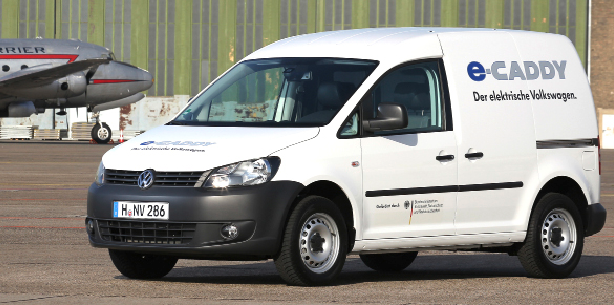Review
Bosses of Britain’s second biggest van brand are convinced that electric mobility is set to play a major role in urban transport.
But Volkswagen has still ruled out putting a full-electric version of one of its best-selling vehicles into full-scale production.
Data gathered from an extensive trial of E-Caddy models is making a strong case in favour of battery power for delivery operations in areas of heavy traffic congestion, but the popular workhorse will continue to be driven by traditional internal combustion engines for the immediate future, Fleet Van can reveal.
One of the stars of a major exhibition staged to highlight electric vehicle technology at the German company, the electric Caddy’s polished performance impressed everyone who drove it through the streets of Berlin.
However, a spokesman for the Volkswagen AG commercial vehicles division told us: “The economics of manufacturing mean this is not going to be a production reality.
“The electric drive system in the latest Mk7 Golf has been developed to operate with vehicles that use MQB, our new group modular platform. As the Caddy is based on the Mk5 Golf, we can’t transfer the technology.
“This is something that can be done only when a completely new vehicle is developed. It would be far too costly for us to import the technology to the present Caddy line – we are already building 90 versions of this vehicle and it takes time to recuperate all the investment this involves.”
The Caddy saw a 22.5% leap in sales in the UK last year to 14,800 registrations, giving it a 19.1% share of the small van sector. Observers had been expecting Europe’s leading vehicle manufacturer to compete with electric versions of the Renault Kangoo, Citroën Berlingo and Nissan’s E-NV200 after staging long-term pilot projects.
In the past two years, electric Caddy models have been in service with local authority departments in Hanover, the city’s building and housing association and DHL, which now runs Germany’s denationalised postal operation.
Developing 85hp and limited to 75mph, the vans have a 550kg payload – 100kg less than the standard van – but retain their four cubic metres cargo space. The underfloor batteries provide a range of up to 68 miles.
“At present we have a fleet of 40 vehicles involved in this research and they are producing a mass of data,” said the spokesman. “Universities are helping us make a thorough analysis of the findings and the feedback is positive. We have gained a lot of valuable experience.”
Looking ready to roll into the showrooms, the E-Caddy concept keeps much of the standard dashboard layout and control gear and neatly incorporates a large colour touchscreen information display that shows how power is being deployed as well as keeping the driver informed about remaining range.
In acceleration, animated graphics use blue arrows to track the energy flow from battery to wheels. These turn to green and move in the opposite direction to highlight energy regeneration when the brakes are applied.
The absence of a clutch pedal means the concept drives like an automatic once ‘ready’ has flashed up on the instrument display after turning the ignition key.
Operating it is as much fun as it is effortless.
No acceleration figures are available, but the concept zooms away from rest and the general lack of noise makes performance seem particularly brisk.
“Our research is making it increasingly apparent that electric mobility is primarily an urban matter. I can’t give you any information relating to the timing of an E-Caddy for production – but it’s not a case of if, it’s when,” said the spokesman.
















